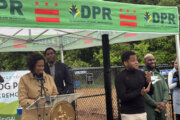Polly Boland and Jenn DiSalvo feel a deep affinity and affection for older adults. Both nurses provide long-term care in suburban ranch houses that are actually skilled nursing facilities re-imagined as small group homes. In each house, 10 older adults receive long-term care in an environment quite different from that of traditional nursing homes.
Although the coronavirus has ravaged many long-term care facilities, small group homes are seeing success in minimizing effects of the virus. To date, at the two St. John’s Penfield Green House homes in Fairport, New York, where Boland and DiSalvo work, the number of COVID-19 cases among residents is zero.
The design of the facilities likely plays a role in preventing the spread of COVID-19. Instead of shared quarters, each resident has an independent room, bathroom and shower.
[Read: ‘SOS Team’ Fights COVID-19 at Skilled Nursing Facilities.]
Infection prevention has become a prime focus for Boland, DiSalvo and the “shahbazim” — a term coined by Green House denoting certified nursing assistants with extra training to work in the small group home model. “Shahbaz” means “nurturer and protector,” DiSalvo explains.
Staff members identified everything they needed to do — like cleaning high-touch surfaces at least twice daily, including wiping down every light switch and doorknob in the facility — and figured out how to make it happen, she says.
“That’s how I think we’ve been able to keep (the virus) out of the facility, because the staff has really taken ownership of the elders who live here,” DiSalvo says.
Boland and DiSalvo both relish the opportunity to really get to know individual residents in a smaller, more intimate environment. “It’s about quality of life for them and I truly believe that’s where we need to be,” DiSalvo says.
“It’s just like you’re at home with your grandparents,” says Boland, who opened the two Penfield Green Houses in Fairport (near Rochester, New York) in 2012.
DiSalvo is a nursing director without an office or desk — and that’s what she prefers. “I’m actually out and about in the houses every day — talking with the elders, spending time with the staff,” she says. “I’m very visible, so people can get in contact with me. I could be doing care, or toileting somebody or just spending time with an elder holding their hand because they’re struggling for the day.”
Boland’s official title is nurse-leader guide. The staff makeup at the group homes diverges somewhat from that of traditional nursing homes. The direct caregiver role of the shahbazim is another unusual feature of Green House facilities.
The difference between the role of a shahbaz and the standard CNA role is “really getting to know your elders,” Boland says. “(The shahbazim are) the ones that run the house, within parameters. But they do everything — from shopping to cooking and cleaning, to having conversations with families and reporting to the nurse if they see a change in somebody.”
Because the shahbazim spend so much time with each resident, Boland says, they’re often the first to say “Something’s not right,” when they spot subtle changes.
[READ: Expert: Nursing Home Workers Have the Most Dangerous Job in COVID-19.]
Not a single resident at either of the St. John’s Penfield group homes has tested positive for COVID-19. However, some staff members have been infected by the virus. Among staff, five cases of positive tests occurred from the beginning of February through the end of August.
Nationally, the Green House Project, dedicated to the small-home concept for long-term care, compiled a report on the impact of COVID-19 throughout its facilities, The report includes data from 262 of the 300 total Green House homes, which comprise skilled nursing, assisted living and family care, and are all built and operated on the small-house model. The study also includes 46 small homes — owned and operated by Otterbein SeniorLife in Ohio — that are similar to Green House homes.
The findings encompass slightly more than 3,300 residents from February through July. In terms of residents being infected, 85% to 100% of homes were COVID-free during three distinct study periods, suggesting efforts like DiSalvo’s and Boland’s — and other Green House teams — are working.
[Read: Physical Therapist: COVID-19 Patients ‘Sicker Than We’d Ever Before Seen’]
As the pandemic deepens, residents at nursing homes everywhere still crave normal human contact free of barriers including personal protective equipment worn by staff.
DiSalvo describes a small but telling incident: “Last week, I was spending time with one of our ladies and she actually knocked the face shield off my face. ”
“Oh, I need to wear that,” she told the resident.
“But I need to see you,” the resident said.
The resident understood that the face shield was there for a reason, Di Salvo notes. “But she also knew that, typically, I would give her a kiss on the cheek or I would hug her. Now I’m not able to give her that kiss, normal things that we’d do every single day.”
Boland hears similar feedback from residents about PPE garb. “They have made comments like: ‘With all this on, I can’t see your smile,'” she says. “Which is hard. But they’ve really adapted to it, better than some of the staff has.”
Staff members go into group homes “to really be the change and have those connections,” Boland says. “You walk by somebody and you might want to give them a kiss or a hug. And it’s harder to do that now.”
Family visiting restrictions are particularly hard on residents. Window visits — in which family members speak from outdoors through a slightly open window to the resident sitting indoors — are available but in limited daily slots. Valuable family togetherness is lost and that time may be irreplaceable. Some residents who are fully aware of the pandemic are angry about missing out on previously frequent, spontaneous family visits, Boland says.
“Some of the older elders who may not know there’s a pandemic going on know that something is going on,” DiSalvo says. For them, it’s difficult to understand why they can’t see their spouse of many years, for instance.
Depression is an issue wherever people of any age are confined to home and missing their loved ones. The Green House residents are no exception. “The hardest part is just seeing them sad,” Boland says. “I hope we never have to live through this again.”
[Read: Helping Nursing Home Residents Overcome COVID-19 Isolation.]
Communal dining has unavoidably changed. Mealtimes used to bring the entire households close together. “It’s one large table that everyone just sits around,” Boland says. “There were days you couldn’t fit in one more chair — it was overflowing with family members, staff and elders. That was a normal day for us.”
Now, fewer residents can eat meals at the main table at once. “The staff sits 6 to 10 feet away from the table, but still try to have that connection with elders,” Boland says. “Talking with them, sharing stories about what’s going on.”
Green House residents are encouraged to feel like part of the surrounding neighborhood. For now, typical community outings like fall foliage rides are out of bounds. However, residents continue to show resilience with pandemic restrictions. And the staff still finds ways to celebrate birthdays and special occasions to help fill the void left by the decreased family contact.
“I love the elderly,” DiSalvo says. “They have so much history and so much to share with us.” Raised by her grandparents, she says, “I’m an old soul to begin with. So I connect with them.”
“You can tell that they’ve all lived a life where sometimes they struggled,” Boland says. “So, they are teaching us so much about getting through this, also. This isn’t necessarily the hardest time in their life. They’ve had harder. And it’s just knowing we have each other.”
More from U.S. News
Beyond Bingo: Innovative Activities at Today’s Nursing Homes
Types of Rooms in Assisted Living Communities
Personal Protective Equipment (PPE): Definition and Examples
Keeping the Pandemic at Bay in Small Group Nursing Homes originally appeared on usnews.com






